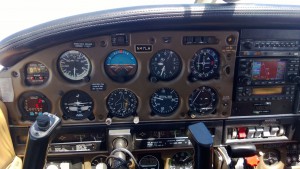
What do these two topics have in common? More than you might think…
I spent the majority of my career in professional services and product management in the software industry. Every product lifecycle follows the established pattern of “Assess, Design, Deploy, and Manage” or something along those lines. The focus is often brought on the assessment phase where we gather technical and business requirements, see what our users have and use today, add future requirements and then use that collected wisdom to design and build the “new” solution – whatever the new thing is.
In my past at Citrix Systems and now at Lakeside Software, our customers are mostly concerned about assessing the existing physical desktop estate and translating the data into future virtual desktop and application delivery architectures. As a matter of fact, since joining Lakeside Software in the Summer of 2013, I have heard numerous times from customers, partners, and even competitors, that we’re known as the Assessment Company in the desktop virtualization and application delivery space.
Let me take a step back for a second and talk to you about my other career – that of a passionate pilot and flight instructor.
While I was in grad school back in 1999 my cousin gave me a ride in a 2 seat Cessna 152 over the Dallas / Fort Worth area at night. I was instantly hooked and started taking flying lessons about a week later. After a couple of months of hard work, plenty of tutoring sessions for high school students, building websites for the local flight school and other activities that would earn me some time in a 30 year old prop plane, I finally was the proud holder of a private pilot certificate. The flying bug had bitten me big time. I continued to earn my instrument rating, commercial pilot’s license, multi-engine rating and glider rating in the ensuing months and years.
One night, I was invited to a barbeque with a couple of flight instructors and professional pilots and there was talk about how difficult it was to obtain a flight instructor license and how high the failure rate for the practical test was – especially compared to the practical tests for other certificates and ratings. “I can do it!” I blurted out (this was a few beers into the night) and found myself having to defend my personal honor. I studied hard and became a flight instructor in early 2005 (Yes, I did pass that beast of a practical test on the first try, but it wasn’t all that easy as I thought it would be.)
While I never attempted to earn a living in the aviation community, I have been teaching aviation safety and flying quite a bit. First as a weekend instructor at the local flight school and then conducting mostly checkouts and flight reviews as the chief pilot of my local aero club here in Florida. I also did a stint as a mission pilot with the civil air patrol.
 Now – what does that have to do with assessments?
Now – what does that have to do with assessments?
Let’s talk about how a typical flight is conducted. It all starts with the pre-flight planning probably a couple of days or hours before we go somewhere. This is all about where to go, what airports and facilities are available, what the weather might be like, if an airplane is available in the club or at the local flight school / rental place, etc. This is the general and initial assessment of the situation.
As we get to the day of the flight, we assess a bunch of additional things. The man (or woman) – in terms of physical fitness to fly. I assess how I feel and if I have taken any medication or gotten enough sleep. Next, I’d assess the overall environment. Weather, Air Traffic Control delays, best route of flight, best altitude, runway closures, etc. Then the machine (the aircraft): Does it have all the required documentation on board? Have the required inspections been performed? Do we have enough fuel and oil? Is the total weight and balance within the envelope? And is the airplane airworthy and fit to fly?
All these items are assessed with the help of a checklist and by physically walking around the aircraft and asking ourselves every step of the way “Is this still good to go?” after checking the requisite items.
Then I’ll do an assessment of my passengers – are they good to go, comfortable, prone to motion sickness?
Finally, we get into the airplane and I again grab the checklist and follow the procedures to start the engine, taxi to the runway, talk to air traffic control and watch for other aircraft, people, and equipment on the airport. You can call that an on-going assessment of the situation.
After taxiing to the runway, there is a pre-flight run-up check where we test that the engine is producing power, all instrument show airplane parameters within the prescribed limits and then we can finally begin to be ready for takeoff.
My radio call is promptly answered by the tower “CHEROKEE FOUR SEVEN LIMA HOTEL, CLEARED FOR TAKEOFF RUNWAY ONE ZERO, LEFT TURN OUT APPROVED, CLIMB AND MAINTAIN TWO THOUSAND FEET”.
Ready to go. As I advance the throttle, I quickly check my engine instruments and we roll down the runway. At about 60 knots indicated airspeed, I gently pull back on the yoke which causes the nose wheel to just lift off the tarmac and we’re in the air a moment later.
I again constantly check for birds, other traffic, radio calls, changing weather, fuel status, passenger well-being, and so forth. I absolutely love the feeling of being in the air and controlling the aircraft, but I have to be constantly assessing the situation (again, man (or woman), machine, environment, external factors, etc.)
After landing, I taxi the plane to the ramp or back to the hangar, conduct my post-flight checklist, turn all systems off and basically conclude this final assessment before I begin to enjoy the destination.
Did you notice what I did NOT do? I did NOT unplug the GPS, the fuel gauges, engine monitor, volt and ammeter, oil pressure gauge, etc. the second I got into the air. Why not? Because I need those things to constantly assess the situation and bring the flight to a successful and safe conclusion. It would be insane to turn off my instrumentation the second the nose wheel leaves the ground, the air grabs the wings, and the ground vanishes beneath me.

Having said this – WHY then do we in the IT world simply stop the assessment the minute the first user is live on our new system? Why do we think that once we assessed the current environment, that the users need, the system status and other things remain stable and constant? Sure – you might argue that nobody’s life is at risk if a server goes down, a service crashes, or the user experience starts to degrade. But come on – if I am trying to be as diligent and professional on the ground as I am in the air, I have to be in the habit of constantly assessing and reassessing the situation, recognizing patterns, learning how to remediate adverse situations and basically keeping the IT environment in perfect shape so that all users can successfully complete their flight, I mean, their work or project.
Some people call this “monitoring” or “IT operations” but what we’re really doing is continuously assessing very large and very complex IT systems and trying to control and manage them in the safest, most stable, and most flexible way.
As an example, this is particularly important for organizations that run Citrix XenApp in their environment and are looking to upgrade from the IMA architecture of XenApp 6.5 (and prior versions) to the FMA architecture in XenApp 7.0 an higher. This whitepaper describes the process in detail.
Another interesting read is out solution brief for end user success.
Thoughts? Ideas? Please comment or contact me on twitter:
@florianbecker
Subscribe to the Lakeside Newsletter
Receive platform tips, release updates, news and more



